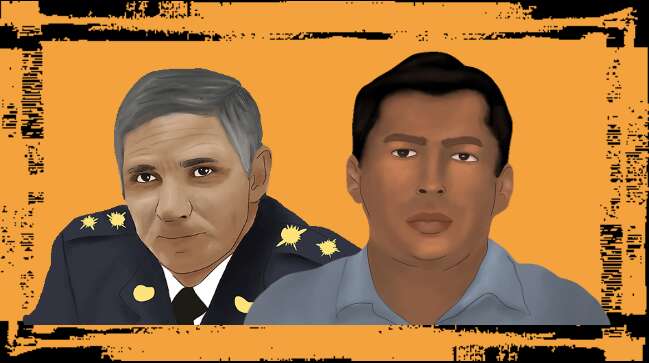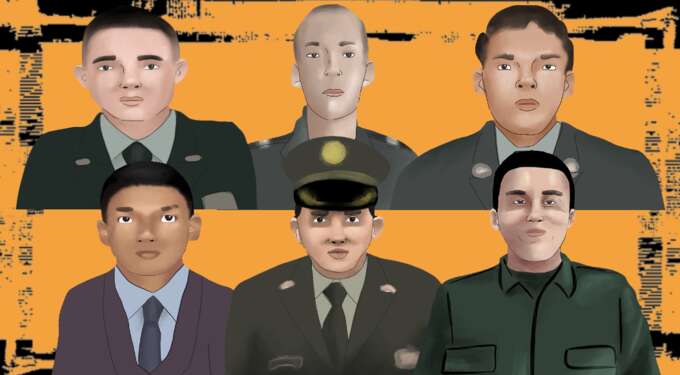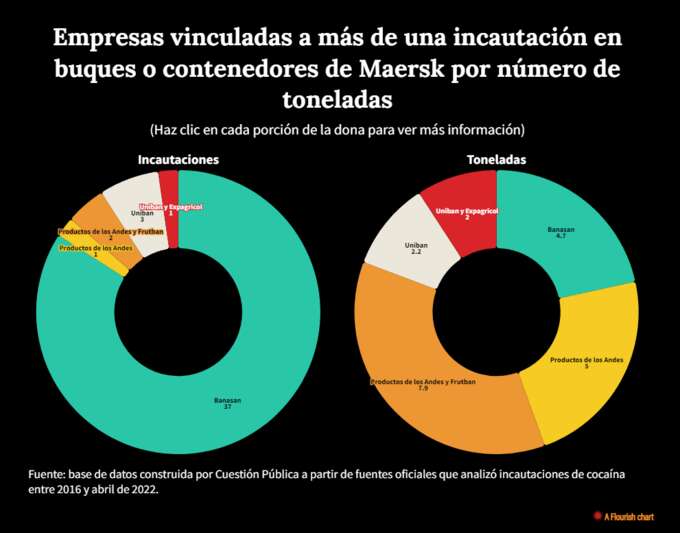
Military intelligence officers and police, in a network with the principal of Daniel “El Loco” Barrera, sent 19 tons of cocaine to Central America, the United States and Europe; They corrupted inspectors at the port of Santa Marta to ship 70% of the drugs to the Danish shipping company.
A man with an electronic bracelet from the National Penitentiary and Prison Institute (Inpec) and a major from the Colombian Air Force (FAC) were waiting for the Police commander of the Santa Marta port terminal. It was June 24, 2017. They had met at six in the afternoon at the Tequendama Hotel in that city.
Without cell phones to avoid recording the meeting, Antonio Aldemar Ávila Acevedo, alias Tony, searched the commander of the port terminal. He proposed that he let them pass the drugs and in exchange, “they would send him his little detail (...) 400 million once the container (with cocaine) left the port and another 400 once it reached its destination.”
That afternoon, together with the major of the FAC, Fabián Andrés Leyton Vargas, Tony told him that he had already introduced three shipments into the port: one hidden in polypropylene bags (plastic for making containers), destined for Guatemala; another in sheets of drywall (construction material), which were going to Algeciras, Spain; and a last one in palm oil cans heading to Veracruz, Mexico. In total, they camouflaged almost three tons, according to documents from the Prosecutor’s Office.
In the following months, the shipments fell one after another. The only one that managed to leave the country did so through the Maersk Willemstadt ship. It was known because the undercover agent, present at the Tequendama meeting, leaked to the authorities the data on the containers and substances in which the drugs were hidden.
The case was identified by authorities as Perla Negra. The Prosecutor’s Office investigation established that this structure trafficked 19 tons between June 2017 and December 2018. At today’s prices, the seized drugs would have a cost close to 455 million dollars, more than 1.7 trillion pesos.
Public Questions and OCCRP created a unique database of these seizures and were able to establish that Maersk was the preferred in the Black Pearl case to transport the drug, since 7.5 out of every 10 kilos of the alkaloid traveled aboard the emblematic shipping company of Denmark, which in 2023 moved almost 12 million containers around the world.
TONY CORLEONE AVILA
Alias Tony was no newbie to drug trafficking. He had been the was called the Modern Pablo Escobar. Captured in 2012, Barrera had built a vast structure of collaborators that included paramilitaries and guerrillas to export cocaine to the United States and Europe.
The electronic bracelet that Antonio Ávila wore at the meeting in Tequendama was a reminder of that past.
By then, he had not finished paying the sentence for drug trafficking that a judge had imposed on him in 2009, and which he was serving from his home citing heart problems, as documented by El Tiempo . Although he accepted charges for trying to send almost 10 tons of cocaine camouflaged in plasticine through the port of Barranquilla, justice gave him the opportunity to work driving a truck.

Antonio Ávila, alias Tony, was the head of the criminal structure that sent nearly 15 tons of cocaine abroad through Maersk ships. Illustration: César Nieves.
By 2008, the year Tony was captured, an informant from the authorities pointed to El Loco as the almighty of the Colombian mafia. His associates ranged from Daniel Rendón, alias “Don Mario”, former head of the Clan del Golfo, to Diego Pérez, alias “Diego Rastrojo”, leader of the narcoparamilitary group Los Rastrojos. With them he planned the murder of Wilber Varela, boss of the Norte del Valle Cartel, in Venezuela, according to Insight Crime.
Daniel Barrera’s capacity for corruption , according to sources cited by El Tiempo, included senior intelligence officers of the Army and the Police, who facilitated the shipment of drugs through the routes that he was opening from the east to the north of the country.

The former Vice Minister of Defense, José Javier Pérez Mejía and his then advisor, Major Fabián Andres Leyton Vargas, one of the leaders of the criminal gang in the Perla Negra case. Illustrations: César Nieves.
Tony used the same strategies. By 2017, his network included, in addition to Major Fabián Leyton, alias “El Flaco”, then advisor to Vice Minister of Defense José Javier Pérez Mejía; Fabián Humberto Tovar Caicedo, Army sergeant expert in intelligence; Jose María Fragoso D’Acunti, former police officer in charge of bribery in the port of Cartagena; Javier Antonio Pertuz Llanos, partner of the previous one; and José Mauricio Castañeda Garzón, a repeat criminal with the alias ’El Primo’.
Once their new structure was assembled, what followed was to look for officials within the port of Santa Marta who would allow the drugs to pass through. According to the indictment of the case accessed by Cuestión Pública , Ávila coordinated the bribery of six members of the Police of said port, along with a deputy first sergeant named Trujillo, who was platform chief there.
CORRUPTS
AND YOU WILL SEND
In the Perla Negra case, the gangsters bribed the police officers involved with 764 thousand dollars, that is, more than 3 billion Colombian pesos, with the purpose of guaranteeing the departure of the cocaine through Santa Marta and Cartagena without the cargo being reviewed by the competent authorities. This was corroborated by judicial documents from the United States and Colombia.
Among them was Sergeant Luis Fernando Ramírez Algarra, alias “El Tigre”, who worked in the anti-narcotics company and five other uniformed officers: Jesús Armando Bermeo Medina, Óscar Javier González Romero, Jhon Jairo Suárez Rueda, Ramiro Torres Vargas and Jairo Rodríguez Lozano , who worked as port control inspectors.
Once they were notified that the merchandise came with narcotics, the canine handlers distracted the anti-drug dogs with toys when they passed by the contaminated containers and altered their training so that they did not give warning signals in case they identified narcotics, as documented by RTVC.
In the case of the police, the undercover agent was the one who carried out the ballot draws to determine who should carry out the inspections of the containers. His function was to ensure that the process was adulterated when by chance one of the uniformed men serving the organization was not chosen, according to documents from the Prosecutor’s Office.

Jesús Armando Bermeo Medina, Óscar Javier González Romero, Luis Fernando Ramírez Algurra, Jhon Jairo Suárez Rueda, Ramiro Torres Vargas and Jairo Rodríguez Lozano, accused of drug trafficking and conspiracy for their participation in the Perla Negra case. Illustrations: César Nieves.
Another strategy of Tony’s organization was to mark the bags or bins where the drugs were hidden so that the police could easily identify them and not inspect them.
THE TRIPSCOCA
OF THE BLACK PEARL
On July 27, 2017, 1,771 kilograms of cocaine camouflaged in a shipment of polypropylene (plastic material for manufacturing packaging) from the Colombian exporter Prospectar Internacional SAS were seized in the Port of Santa Marta. That shipment destined for Central America fell, Tony’s hopes They were placed in the one in Algeciras.
Ronald Murgas Payares, the the port of Barranquilla , at the end of June 2023. The merchant Miguel Enrique Vieco Ebratt was also part of this structure, as recorded by El Heraldo .
Between the Murgas network and the drug traffickers in the Perla Negra case there is an additional coincidence: his preference for Maersk Line when it comes to trafficking. Public Question found that two years before the captures, 206 kilos of cocaine camouflaged in iron structures that were on the Maersk Wilmington ship bound for Panama were confiscated from Mar & Air Carga, Miguel Enrique Vieco’s company , according to documents from the prosecution.
In another shipment, Tony’s structure had shipped just over a ton of cocaine camouflaged in sheets of drywall from the Caribe Exporta company to the port of Algeciras, Spain. With the information from the Colombian undercover agent, the DEA and the German and Spanish authorities managed to follow the route of the drugs that were transported on one of the Danish shipping company’s ships.
It happened on the Maersk Willemstadt ship, which set sail from Santa Marta to the German port Bremerhaven on August 22, 2017 with 1,109 kilos of cocaine. There, the European agents extracted part of the drugs and let the rest follow as a decoy on another ship of the same shipping company: the Maersk Lima , according to documents from the Court of Instruction No. 4 of Malaga, Spain.
The drug, valued at 38 million euros, equivalent to 132 billion Colombian pesos at the time, continued heading to Algeciras. Due to these events, José González Roldán, the administrator of the importing company Displasur Soluciones SL, was sentenced to six years in prison and forced to dissolve the company.
Caribe Exporta, a company in whose products the drugs were camouflaged, was established with 35 million pesos on April 30 of that same year, that is, three months before the export. It was dedicated to management consulting and only had a single shareholder and founder: Taylor Eduardo Ortega Grisales.
The one in Algeciras was its first international operation and it only registered one more to Mexico in November 2017, before disappearing from the business, according to records from Panjiva, the global trade database. By 2023, it notified its dissolution before the Santa Marta Chamber of Commerce.
There were six more shipments before the network was dismantled in 2018. They hid the drugs in shipments of bananas, lemons and sports suitcases, bound for the port of Antwerp, Belgium; among piles of pineapples that were discovered in Georgia, United States, and even in wooden boxes containing paper that was confiscated in the port of Santa Marta.
The criminal organization trafficked 68% of the drugs sent to Europe through the same exporter: Productos de Los Andes SAS. In June 2017, Antonio Ávila Acevedo told the undercover agent that this would be one of the companies in charge of carrying shipments of cocaine abroad, since it already had a “record” , according to the Prosecutor’s indictment.

Los Andes Products Headquarters registered with the Sincelejo Chamber of Commerce. The Office is on the second floor. Credit: taken from Google Maps.
Only in the port of Antwerp, the second most important on the old continent and the favorite of Latin American drug traffickers, 13 tons of narcotics were found in shipments from this company. All involved Maersk containers and vessels.
Miguel Iván Galvis, manager of Productos de los Andes, assured this alliance that the exporter has never been linked to criminal proceedings and has been inactive since 2022. He said that they did not have the power to choose the shipping companies , since the person in charge was the cargo agent “which at that time was the company M&G International World (...).”
“Since 2012, the company has not bought, sold, or transported any product to the port. Invoices are made in the name of third parties, who are actually responsible for the exported goods. In the particular case of the seizures, they happened between 2016 and 2017 and were isolated cases in an export record of almost 18 years,” Galvis added.
YES, I SAW YOU,
I DON’T KNOW YOU
According to the judicial file of the Prosecutor’s Office, at least five export companies were involved in the drug shipments of Tony’s organization: Caribe Exporta SAS, Prospectar International SAS, CI Carbones & Fruits del Caribe SAS, Productos de Los Andes SAS and Frutban SAS According to the Prosecutor’s indictment, the first three were explicitly mentioned by the criminal gang in the drug shipments.
Public Questions asked these companies if their representatives had been linked to judicial processes related to drug trafficking. Only Productos de Los Andes responded and indicated no. In the case file of the Prosecutor’s Office to which this alliance had access, no investigations were found regarding its owners and employees, as well as the intermediary agencies.
Only until November 2021, the control entity charged Jesús Armando Bermeo Medina, Óscar Javier González Romero, Luis Fernando Ramírez and Jhon Jairo Suárez Rueda, the police officers who allegedly let the shipments pass through the port of Santa Marta for trafficking and conspiracy to commit a crime The uniformed officers partially accepted the charges and the judge ordered his sentenced to 12 years in prison in the United States, while José Mauricio Castañeda Garzón, alias Primo, was sentenced to seven years and four months in jail. None of the North American judicial documents mention the company that transported the drugs or the numbers and acronyms of the containers.
The big absentee in the Colombian judicial files was also Maersk, who was only mentioned when the drugs were transported on their ships. Whether or not the Danish shipping company was responsible for the transport of the 19 tons of cocaine that this organization trafficked was not analyzed by the Colombian Prosecutor’s Office in its investigation, despite the fact that it transported most of the drugs.
“In Santa Marta there are superfixers who are the owners of the multiple routes that organizations use to send drugs”
When consulted about this alliance, the Danish multinational pointed out that the large number of seizures in its containers and vessels is usually the result of good and proactive collaboration between the authorities and the sector.
The high corruption inside the ports, says Alejandro Matallana, former sergeant of the National Navy of Colombia, who was part of the Anti-Narcotics Directorate (DICOD) of the National Navy, continues to be one of the great challenges in the anti-drug fight at sea.
“In Santa Marta there are the superfixers who are the owners of the multiple routes that transnational organizations use to send drugs: they have contacts there and on the ships . The drugs that pass through the ports are not in kilos, but in tons, a lot of money is moved in these operations, and it is no secret to anyone that State officials are very poorly paid and that is where they begin to infiltrate (... ) and the authority that should be monitoring there is very committed (to organized crime)," he explained.
Bernardo Gómez Del Campo, a former Mexican police investigator and expert on organized crime in Latin America, leans towards failures in the security issue:
“[Maersk] should have a very solid corporate security structure, a preventive business intelligence unit to locate antagonistic groups (corruption) within the company and neutralize them through technology, personnel, internal investigations (…) it has the resources to do so , I should be able to stop them.”
The Danish multinational assures that it is exploring new security measures such as installing tracking devices on its containers. It also states that corruption is one of its great challenges and in 2021 it announced its new “no more business” policy , in which it enabled a search engine on its page to identify companies “or entities that have not complied with the terms and conditions.” “financials of the agreement” to work with Maersk.
However, Cuestión Pública identified that between 2016 and 2023 the Danish transporter carried 44 exports of Productos de Los Andes, the company with a “record” that alias Tony mentioned, and three other Colombian companies from which narcotics had been confiscated in the past.

It is not clear whether Maersk’s "No more business" policy refers only to breaches within the contract or transcends companies linked to cocaine trafficking, or whose merchandise recurrently contains drugs.